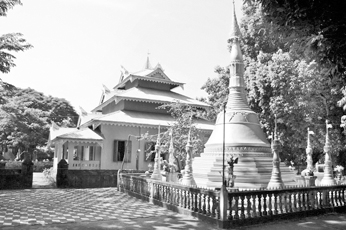
A visit to Maheshkhali
Nilratan Halder | Saturday, 10 January 2015

If the historical background of the Adinath Temple at Maheshkhali has any validity, the 362.2-sq km island derives its name from God Mahadev whose other name is Mahesh. Maheshkhali, according to the myth, comes from Mahesh. In the booklet available at the temple, the hill on the topmost peak of which sits the temple is called mountain Mainak.
Clearly, myth does not quite make up for history. But such tales are quite captivating. For example, Ravan worshipped Mahadev in order to achieve immortality. Mahadev granted Ravan the blessing but with a condition. The condition is that the later would carry Shivlinga from Kailash to Lanka without ever putting it down anywhere for a rest. But Ravan was compelled to rest at the top of the Mainak where Narayan appeared in the guise of a Brahmin and leaving the Shivlinga in his custody, the former went to respond to the call of nature.
Ravana returned to see the Brahmin has gone and now he tried to lift the Shivlinga on his shoulder but despite all his effort he failed to do so. Right at that moment oracle sounded from heaven to inform Ravana, 'your crave for immortality has come to naught'. He was told to go empty-handed. Mahadev made the Mainak his abode.
If this is not enough, the discovery and recognition of the Adinath Temple are more fascinating as those happen at the hands of a well-to-do Muslim named Nur Mohammad Sikder. According to a popular belief, Nur Mohammad had a cow and it stopped giving milk suddenly. He thought the cowboy was responsible for secretly milking the cow and scolded the unfortunate boy regularly. Once the boy followed the cow at night when it came out of the cowshed and started walking towards deep forest. He followed the cow there and to his surprise saw that the cow stood on a black stone on which the cow's milk started falling. The cowboy informed Nur Mohammed who did not take much notice of the incident. But he took the cow to what is known as Bara Maheshkhali. Now he dreamt that the cow would not stop giving milk on the stone even if it is taken away and chained there. Only it would suffer on account of its walk to a longer distance and back. He was, moreover, told to ask the local Hindu zamindar to build a temple there.
The second part of the story is even more appealing and significant. Nur Mohammad was again directed in his dream to bring Astavuja Durga from as far as Nepal. A Naga sanyasi (saint) was assigned the task of bringing the deity from Nepal's state temple. The sanyasi was charged with theft but Mahadeva assured him he had nothing to fear. When the case was opened, the judge asked the king of Nepal what colour the deity of Durga was. In reply the king said it was black of the touchstone variety. When the same question was put to the saint, he replied that the deity was all white.
The judge announced his verdict in favour of the sanysai when the statue was found to be white and the king asked for forgiveness. Then the king wanted to know what the matter was. At this point the sanyasi disclosed the fact and the king was pleased to set up the statue in a temple beside the Adinath temple. It was in the year 1612. At this point history and popular tale have a meeting point with a definite year marking the installation of one of the statues. And from that time, Nepalese government has been giving donation to the temple. Apart from this specific historical date, there is yet another historical association though. Dewan Kalicharan, a representative of Dewan Alibordi Khan's Dewan Brojokishore Lal came to the island with his nine-year old son. Sratchandra by name, the boy became a disciple of the Naga sanyasi. Saratchandra donated all his zamindari property to the Adinath Temple in 1876.
Apparently, myth and history have mingled somewhere and it would be difficult to separate one from the other. But the elements of secularism, the reaching out of religious bound to help a community belonging to another religion offers a very good lesson. This is what religions ought to be. No wonder Maheshkhali is a popular tourist destination of Cox's Bazar.